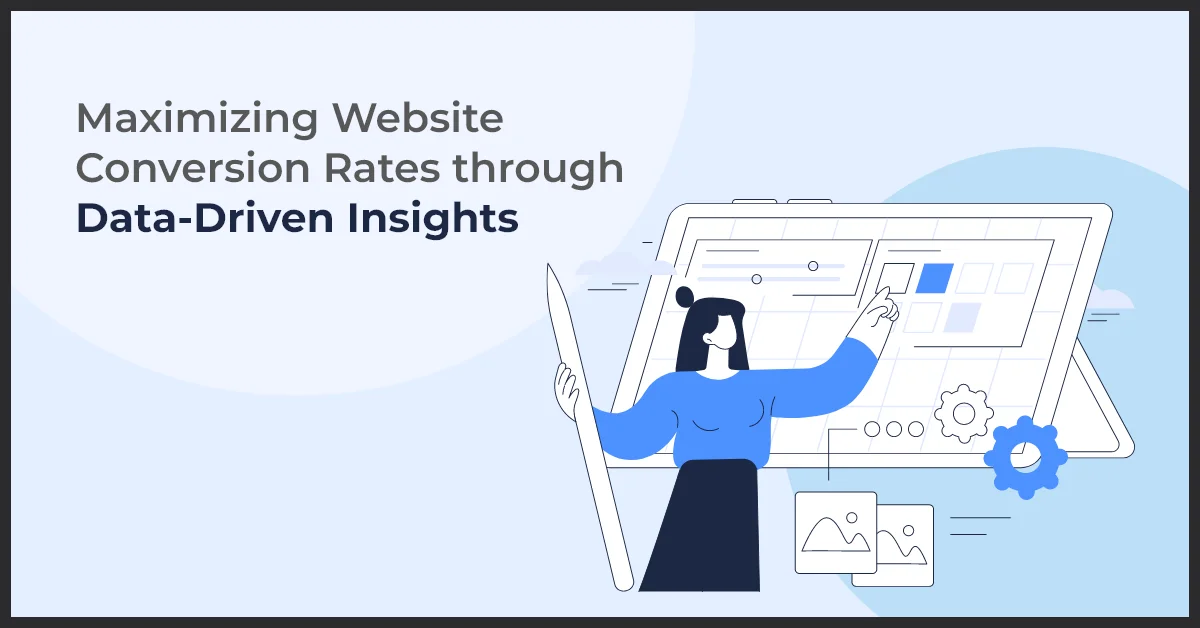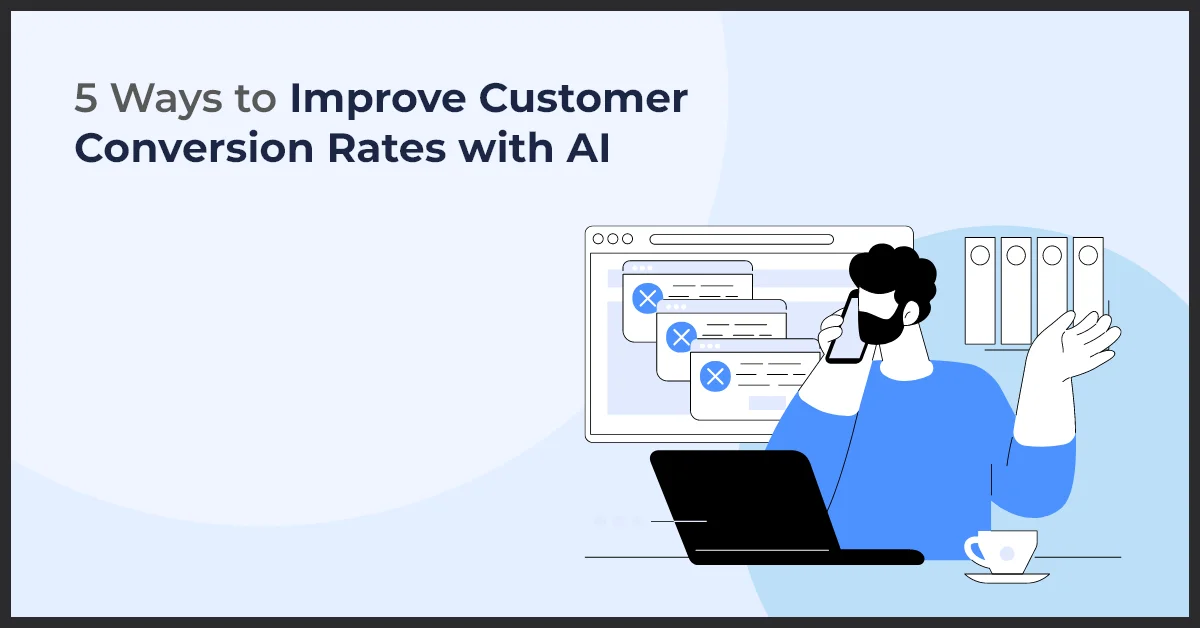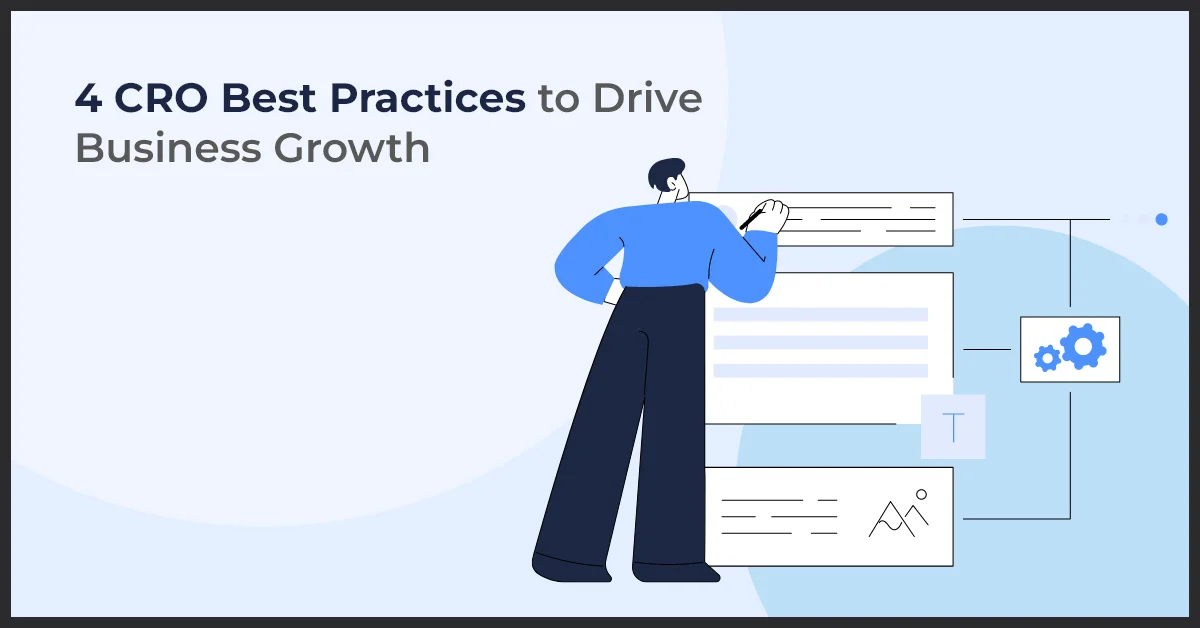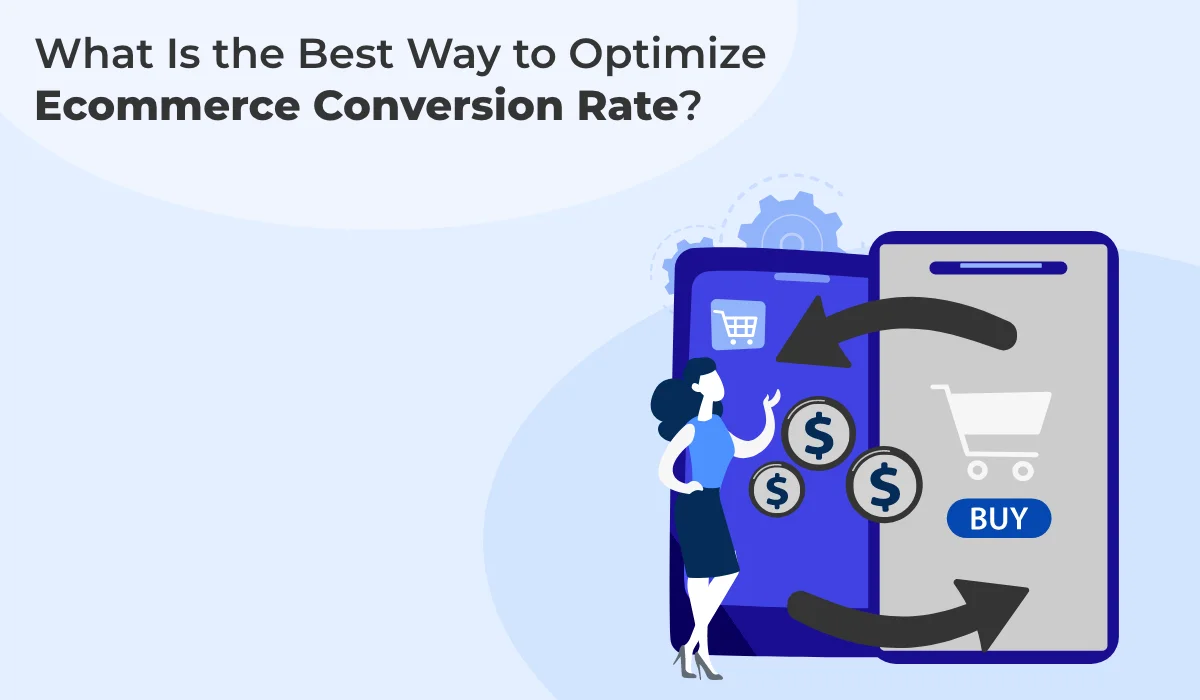Maximizing Website Conversion Rates through Data-Driven Insights

Published on: March 1, 2023
Updated on: July 16, 2024
1080 Views
- CRO
16 min read
Did you know more than 60% of customers are willing to share their details for personalized offers? According to Gartner Research, every three in four business leaders make decisions based on data. As a business owner, you'd have come across similar studies highlighting the importance of data in modern business and how it can put businesses on a growth trajectory.
Data and analytics have been the heart and soul of online marketing. Unlike offline marketing, online marketing allows you to track and use data to make informed decisions. As someone aiming to maximize website conversion rates, data-driven insights should drive strategic decisions.
While every business can access data from their campaigns, not everyone generates insights that power the campaign's growth. What is the path to data-driven insights? How can these insights maximize your website conversion rates? In this detailed guide, we dig deep into the relationship between data and marketing and how analytics tools can help you increase conversion rates.
What Are Data-Driven Insights for Website Conversion Rates?
Business data helps organizations achieve a deep understanding of the success or the lack of it in their marketing campaigns. From knowing where to spend to measuring the ROI of the campaign, data plays a critical role in marketing campaigns. Let's start with the basics of data-driven insights for website conversion.
What Are Data-Driven Insights?
Data-driven insights are conclusions or observations obtained by analyzing large amounts of data. Data analytics tools generate insights that help make strategic decisions based on facts and figures. Organizations adopting a data-driven approach derive inferences from hard data instead of intuition or assumptions. This approach allows organizations to make informed decisions in a quick time based on the trends in the market.
How Do Marketing And Data Insights Work Together?
Marketing and data insights are closely intertwined. Data-driven insights help marketers make informed decisions about their campaigns and overall marketing strategies.
Here are some of the practical applications of data-driven insights in marketing
- Identifying Target Audience - Data-driven insights help identify the target audience. As organizations dive deep into their data, they can identify their most valuable audience based on demography, buying behaviors, and engagement with the brand.
- Optimizing Campaigns – In-depth analysis of data helps in optimizing campaigns. As marketers dig deep into key metrics such as click-through rates, conversion rates, and engagement metrics, they can optimize campaigns based on their performance.
- Personalizing Marketing Campaigns - Personalization is key to success in today's world. Data-driven insights aid the personalization of marketing messages. According to Google, personalized messages trigger buying desire among the audience and increase the conversion rate by 90%.
- Helps in Marketing Attribution - Data-driven insights are useful in attributing sales and conversions to specific marketing campaigns or channels. Marketing attribution lets marketers allocate budgets more effectively and focus on the campaigns that drive sales and revenue.
What Are The Types of Data-Driven Insights?
You can generate and analyze different data-driven insights to optimize your website for higher conversion. These include -
- Quantitative Insights - These are numerical data such as traffic, bounce rates, conversion rates, click-through rates, and time on site. They let you study user behavior and its impact on conversion rates.
- Qualitative Insights – These non-numerical insights include feedback, customer support tickets, and social media comments. Using these, you can identify specific pain points or areas of the website that need improvement.
- Behavioral Insights – These focus on user activity on the website, such as click paths, navigation patterns, and search queries. These give you a better understanding of the needs and aspirations of your users.
- Competitor Insights – It uses third-party and open data to study strengths, weaknesses, and areas for differentiation. It lets you know how your website stacks up against the competition.
Importance Of Data-Driven Insights For Maximizing Conversion Rates
Data-driven insights are critical for improving user experience and maximizing website conversion rates.
Here are some reasons why data-driven insights are important for maximizing website conversion rates –
- Identify Pain Points – Data-driven insights let you identify pain points and areas where your website is failing to convert users into customers
- Study User Behavior – Data lets you study how users are interacting with the website, the most engaging elements on the website, and the reason behind their exit without converting
- UX Optimization - Data-driven insights can help optimize user experience by addressing common problems, such as long load times or puzzling navigation.
- Track Progress – Your website undergoes regular changes, and data-driven insights validate those changes by studying the key performance indicators.
Key Factors That Affect Website Conversion Rates
Conversion rate measures the percentage of visitors to a website taking a desired action. For instance, it is the percentage of visitors placing an order in the case of an ecommerce store. In other cases, it may be the percentage of people filling out a form or signing up for a newsletter. Here are the key factors that affect website conversion rates.
1. Usability and Navigation
Visitors to a website should be able to find what they are looking for easily and complete desired actions without encountering barriers or confusion. The website should be easily accessible with easy-to-access navigation buttons and logical category and subcategory pages.
2. Design and Layout
A well-designed website that appeals to the users and provides a good user experience can significantly impact conversion rates. The website shouldn't be cluttered and have design elements, imagery, and layout appealing to the tastes and preferences of the target audience.
3. Content Quality and Relevance
Content is the most important element in marketing. It applies to all types of content, including product descriptions, blog posts, and other information. When content appeals to the audience, it improves the conversion rate. The content on the website should be high-quality and relevant to the target audience.
4. Load Time and Performance
Website visitors expect pages to load quickly. Longer page load time is the greatest threat to engagement and conversion on a website. Most users abandon a website that takes more than three seconds to load.
5. Social Proof and Testimonials
Social proof and testimonials have become important selling factors. Websites witness a higher conversion rate when users trust the website and believe it to be legit with its products and information. Trust signals such as customer reviews and testimonials can turn a casual onlooker into a paying customer
How to Collect Data for Website Conversion Rates Analysis?
We have already covered the basics of data-driven insights for website conversion rates and discussed the key factors affecting conversion rates. Let us look at the process of collecting data for website conversion rate analysis in detail.
Role of Analytics Tools
Analytics tools play a crucial role in analyzing conversion rates. These tools provide marketers with details on how users interact with a website. With the help of these tools, your marketing team can study factors that trigger users' actions, such as adding products to a cart, filling out forms, subscribing to newsletters, etc. More importantly, these tools allow marketers to zero in on the scope for improvement and optimize conversion rates.
Types Of Data To Collect For Website Conversion Rates Analysis
Conversion rate analysis helps better understand your users and their shared behavioral trends. Businesses must segment their users to create more personalized campaigns and content for increased conversion. It starts with collecting accurate data about the customers. These include -
- Location of the customers, age, and demography
- Devices customers use to access the website
- Keywords used to reach the website
- Marketing channels drawing customers
- Activity and time spent on the website
- Number of visits leading to a purchase
- The most popular products and services
- Drop-off point on the website
- Common behavioral trends for segmentation
Best Tools For Data Collection
Businesses use different tools to collect and analyze data depending on their needs and preferences. These tools help study customer journeys and workflow and better understand what marketing strategies are working and, more importantly, why visitors aren't converting.
Here are the best tools for data collection.
- Google Analytics
- Adobe Analytics
- SurveyMonkey
- HubSpot
- HotJar
- Heap
- Crazy Egg
- FullStory
- Optimizely
- VWO Testing
- Instapage
Analyzing Data for Website Conversion Rates Improvement
Analyzing data is an essential component of improving website conversion rates. Let us look at its importance, key metrics to track, and the most widely used data analysis techniques.
Importance Of Data Analysis For Website Conversion Rates Improvement
As previously discussed, data analysis provides valuable insights into how users interact with a website. By analyzing this data, marketers can identify areas of improvement and make data-driven decisions. Data analysts help marketers in the following ways –
- Understanding the behavior of the users and the action they take on the website
- Studying the scope of improvement in the website and pinpointing problem areas
- Tracking the progress of the marketing campaign and identifying broad trends
- Testing different hypotheses that may influence the conversion rate
Metrics To Measure For Website Conversion Rates Analysis
It is impossible to ascertain the success or failure of a campaign without analyzing the conversion metrics. Businesses use different metrics to measure website conversion rates depending on the business type and revenue model.
Here is a list of the most widely used metrics -
- Pageviews
- Click-through rate (CTR)
- Bounce Rate
- Interaction per visit
- Cost Per Acquisition (CPA)
- Time on Site
- Exit Rate
- Cost Per Conversion
- Return on Investment (ROI)
Examples Of Data Analysis Techniques For Improving Conversion Rates
You can employ several data analysis techniques to improve your website's conversion rate. These include:
- Funnel Analysis - Funnel analysis involves tracking the user journey from the first site visit to conversion and everything in between. Funnel analysis helps you identify where users drop off and take corrective actions.
- Segmentation Analysis - Segmentation analysis involves dividing the user base into segments based on demographics, behavior, and other commonalities. With this, you can identify how each segment interacts with the website and tailor the user experience to improve conversion rates.
- Time on Page Analysis - In this, you track how long users spend on each website page. By analyzing how long users spend on each page, you can identify which pages are most engaging and optimize those pages for higher conversion rates.
- Exit Intent Analysis – In this analysis, you track the page where a user exits your website and create targeted messaging or offers to encourage them to stay. It helps in reducing the bounce rate and increasing conversions.
Methods For Improving Conversion Rates Derived From Data
Data offers you actionable insights for improving conversion rates. You can improve the conversion rate based on the intelligence derived from data in different ways.
Let us turn our attention to some of the most widely used methods for improving conversion rates –
- Personalization - Tailoring the user experience based on the user's preferences and behavior helps improve the conversion rate. Data lets you understand user behavior and preferences, which you can use to provide a personalized experience that can lead to higher conversion rates.
- Mobile Optimization – Mobile phones have become the go-to device for browsing websites. Optimizing your website for mobile users helps improve user experience and engagement, leading to increased conversion rates.
- Content Optimization – Optimizing content that resonates with your target audience helps increase conversions. Using data, you can identify the language and type of messaging that improves engagement on your website.
Implementing Changes Based on Data Insights for Improved Conversion Rates
Data-driven optimization is essential for businesses that want to improve website conversion rates. Let us look at their importance, best practices to implement changes, and common examples of changes based on data-driven insights.
Importance of Data-Driven Optimizations For Conversion Rates Improvement
Data-driven optimization allows businesses to make informed decisions about the changes they make to their website.
Here's why it is important to optimize your website based on data-driven insights –
- They let you identify areas of improvement in your website, especially in the case of underperforming websites.
- They let you make informed decisions based on facts and figures instead of assumptions and gut feeling
- They let test different variations of the website to identify which ones perform best and maximize conversions
- They let you improve user experience and increase the likelihood of visitors converting into customers.
Best Practices For Implementing Changes Based On Data Insights
Data insights offer marketers actionable intelligence on ways to improve conversion rates. However, these insights act merely as a guide, and you must implement them flawlessly.
Here are the best practices for implementing changes based on data insights –
- Set Goals – Set clear goals on the purpose of these changes. You may not need to implement all the changes, so you implement changes aligned with your business goals.
- Prioritize – Identify changes that can have the biggest impact based on data insights. Start by implementing changes that are easy and can potentially have maximum impact.
- Run Tests – Don't implement any change without running a test. A/B Testing is the most popular.
- Go Slow – Don't implement all changes in a single day! Implement them gradually to measure the impact of every single change.
- Monitor Results – Once you implement the changes, track results to study their impact on conversions.
- Document Changes – Always document all your changes as they let your team study the pros and cons of these changes for the future.
Examples Of Changes To Implement Based On Data Insights
You can make several changes to your website based on data insights to improve conversion rates.
Here is a list of the most common changes you can make to your website –
- Landing page redesign
- Navigation redesign
- Mobile-first approach
- Streamlining user experience
- Optimizing website speed
- Improving checkout process
- Altering CTA elements
- Content personalization
Testing and Measuring the Impact of Changes on Conversion Rates
Testing is critical in improving website conversion rates, enabling businesses to identify what works best for their audience. Let's examine why it is important, the types of tests businesses conduct, and their impact on conversion rates.
Importance Of Testing For Website Conversion Rates Improvement
Testing and measuring the impact of changes on conversion rates lets you examine the factors that influence your visitors' decision-making and the changes you need to implement to maximize conversions.
Here's how it can help your website -
- Testing lets you identify the best-performing website design. You can experiment with different designs and layouts and choose one that strikes a chord with your audience
- Your website will have different segments of users with unique aspirations and needs. Testing lets you optimize the website for different categories of audiences.
- Assumptions about the market and audiences drive businesses. Testing lets you validate these assumptions.
- Web development is a continuous exercise; you must put every change through rigorous testing to be ahead in the game.
Types Of Tests To Conduct For Website Conversion Rates Improvement
There are several approaches to testing for improving website conversion rates. Here are some of the most common types of tests -
- A/B Testing – It is the most widely used test and involves comparing two web page versions and choosing the best performing one. In this test, businesses keep one version (the control version) unchanged while the other version (the variant) is modified. These versions are shown to different groups of users to identify the most effective one.
- Multivariate Testing – It is similar to A/B testing, but businesses test multiple versions of the website instead of testing only two versions. Elements of the page, such as headlines, images, and CTAs, are varied to identify the best combination for higher conversions.
- User Testing – As the name suggests, this involves tracking users' activity on the website to Identify usability issues and scope for improvement. It is done both in-person and remotely and provides valuable insights into the changes you must make.
- Heatmap Testing - Heatmap testing software tracks how users interact with different elements on your website. It generates a visual representation of where users click and spend the most time. It allows you to study the performing and non-performing assets on the website.
- Exit Intent Pop-up Testing - It involves using pop-ups at the exit and encouraging users to stay on a website. Customized pop-ups increase conversions and collect data on ways to improve user experience.
Examples Of Testing Tools For Measuring The Impact On Conversion Rates
You have a wide choice of testing tools for measuring the impact of data-driven insights on your conversion rates.
Here are some you can try –
- Google Optimize
- Crazy Egg
- FullStory
- Adobe Target
- WebPageTest
Final Thoughts
To sum up, we have covered the basics of data-driven insights, factors affecting conversion, and ways to collect data for conversion rate analysis. We have covered ways to improve conversion rate and the importance of testing and best practices for implementing data-driven insights on your website. We have also looked at the tools used for data collection and measuring the impact on your website conversion rates.
The bottom line is that data-driven insights are essential for maximizing website conversion rates because they clearly understand how users interact with your website. By analyzing data, you can identify patterns, trends, and areas for improvement that boost your website's conversion rate and growth. It is important to adopt a data-driven mentality and make informed decisions, keeping assumptions and gut feelings away. Covid-19 has changed the world and the structure of our society. Data-driven insights can help your business stay viable and thrive in an increasingly digitized world.
If you need a partner to implement these changes, we at Growth Natives can power your dream. We are a data-driven company and help clients build exceptional online experiences for their target audience. Set up a consultation with our team by emailing us at info@growthnatives.com and be part of the change.
Sources:
https://www.thinkwithgoogle.com/future-of-marketing/creativity/marketing-personalization-statistics/
Frequently Asked Questions
To optimize your website conversion rate, consider the following steps:
- Identify your conversion goals (e.g., form submissions, purchases).
- Improve website usability and user experience.
- Create compelling and relevant content.
- Use clear call-to-action (CTA) buttons.
- Implement A/B testing to experiment with different elements.
- Analyze data and make data-driven decisions to optimize performance.
Key metrics to focus on include:
- Conversion Rate: The percentage of visitors who complete a desired action.
- Bounce Rate: The percentage of visitors who leave the site without interacting further.
- Average Session Duration: The average time visitors spend on the site.
- Exit Rate: The percentage of visitors who leave the site from a specific page.
- Interpret these metrics by comparing them to industry benchmarks, identifying trends over time, and correlating them with changes made to the website.
You can monitor website conversion rate using tools like Google Analytics. Set up conversion goals to track specific actions (e.g., form submissions, purchases) and regularly review the data to identify areas for improvement.
Conversion rates can vary widely depending on the industry, type of website, and conversion goal. However, a good benchmark for an e-commerce website is around 2-3%, while for lead generation websites, it can be higher, around 5-10%. Ultimately, the best conversion rate is one that is continually improving based on your specific goals and objectives.



